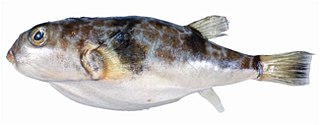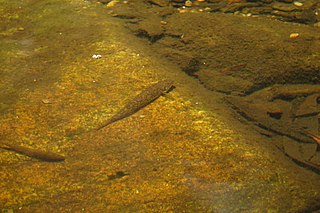Dendropsophus aperomeus is a species of frog in the family Hylidae. It is endemic to Peru and occurs on the Amazonian slopes of the Andes in northern and central Peru. Common name Balzapata treefrog has been coined for it.
Cornufer parkeri is a species of frog in the family Ceratobatrachidae. It is endemic to the Papua New Guinean part of the Solomon Islands archipelago and is only known from the islands of Bougainville and Buka. The specific name parkeri honors Fred Parker, Australian naturalist and explorer who collected the type series. Common name Parker's wrinkled ground frog has been proposed for this species.
The whitefin swellshark is a species of catshark, belonging to the family Scyliorhinidae, endemic to southeastern Australia. It is found 126–554 m (413–1,818 ft) down, on the outer continental shelf and upper continental slope. Reaching 1.1 m (3.6 ft) in length, this shark has a very thick body and a short, broad, flattened head with a large mouth. It is characterized by a dorsal color pattern of dark saddles and blotches over a brown to gray background, and light fin margins. When threatened the whitefin swellshark can inflate itself with water or air to increase its size. Reproduction is oviparous. As of 2019 The International Union for Conservation of Nature (IUCN) has assessed this species as Critically Endangered due to the significant decline of the population.
The saddled swellshark is a rare species of catshark, and part of the family Scyliorhinidae, endemic to Eastern Australia. This bottom-dwelling species is found on the outer continental shelf and upper continental slope at a depth of 115–605 m (377–1,985 ft). It is a robustly built shark with a short, broad, flattened head and a capacious mouth. Adults are patterned with saddles on a brownish or grayish background, which varies between tropical and temperate sharks; juveniles are light-colored with many spots. This shark reaches 74 cm (29 in) in length. Like other swellsharks, it can inflate itself as a defensive measure. Reproduction is oviparous.

The camouflage grouper, also known as the blue-tailed cod, camouflage rockcod, small-toothed rockcod, smooth flowery rock-cod, snout-spot grouper or snout-spot rock-cod, is a species of marine ray-finned fish, a grouper from the subfamily Epinephelinae which is part of the family Serranidae, which also includes the anthias and sea basses. It has a wide Indo-Pacific distribution where it is associated with reefs.

The alligator pipefish or double-ended pipefish is a species of fish in the family Syngnathidae and is the only species in the monotypic genus Syngnathoides. It is found in shallow water in the tropical and subtropical Indo-Pacific, its range extending from East Africa to northern Australia. This fish lives in habitats of seagrass and seaweed, and hides by positioning itself vertically with its head down amidst the similar-coloured fronds of vegetation. The elongated, well-camouflaged body can reach 29 cm (11 in) in length. It feeds by sucking up its prey.

The potato grouper, also called the potato cod or potato bass, is a species of marine ray-finned fish, a grouper from the subfamily Epinephelinae which is part of the family Serranidae, which also includes the anthias and sea basses. It has a wide Indo-Pacific distribution.

The Christmas wrasse, also known as the ladder wrasse, green-barred wrasse or green-blocked wrasse, is a species of ray-finned fish, a wrasse from the family Labridae which is native to the Indian Ocean and the western Pacific Ocean. It inhabits shallow reefs at depths from the surface to 10 m (33 ft). It is of minor importance to local commercial fisheries and can be found in the aquarium trade.

Reicheltia halsteadi, Halstead's toadfish, is a species of pufferfish endemic to Australia. This species grows to a length of 16 centimetres (6.3 in) TL. This species is the only known member of the genus Reicheltia.

Cephalopholis fulva, the coney or the butterfish, is a species of marine ray-finned fish, a grouper from the subfamily Epinephelinae which is in the family Serranidae which also includes the anthias and sea basses. It is found in the western Atlantic. It is associated with reefs and is a quarry species for commercial and recreational fisheries. It can be found in the aquarium trade.

Acanthurus dussumieri, commonly known as Dussumier's surgeonfish, the eye-stripe surgeonfish or the ornate surgeonfish, is a ray-finned fish from the Indo-Pacific. It occasionally makes its way into the aquarium trade. It grows to a maximum length of 54 cm (21 in) but 35 cm (14 in) is a more usual size.

Awaous acritosus, the Roman nose goby, is a species of goby that is native to fresh water rivers and streams of Queensland, Australia and the Laloki River drainage of New Guinea.

The longfin grouper, also known as the longfin rockcod, bar-breasted rock-cod, Gilbert's rock-cod, honeycomb rockcod, spotted groper or wirenet cod, is a species of marine ray-finned fish, a grouper from the subfamily Epinephelinae which is part of the family Serranidae, which also includes the anthias and sea basses. It is found in the Western Pacific Ocean.

Coleman's pygmy seahorse is a species of fish of the family Syngnathidae. It is found off of the coast of Lord Howe Island, Australia, although unconfirmed occurrences have been reported from Milne Bay and the Ryukyu Islands. It lives in coarse sand and Zostera and Halophila sea grasses at depths around 5 metres (16 ft). It is expected to feed on small crustaceans, similar to other seahorses. Ovoviviparous reproduction is also expected, with males brooding eggs in a pouch before giving birth to live young.

The broomtail grouper or mangrove grouper is a species of ray-finned fish from the family Serranidae which is found in the eastern Pacific along the western coast of the Americas from California to Peru.

Campichthys tryoni is a species of marine fish of the family Syngnathidae. Little is known of this species, but the specimens that have been collected were found on the Queensland coast off of northeastern Australia. It is a rare mainly tan coloured pipefish with brownish markings, it has a white blotch over the eyes, a pale patch above the operculum and it has small white dots along its back and tail. The males frequently show irregular dark barring along their ventral surface. This species is ovoviviparous, with males carrying eggs in a brood pouch until giving birth to live young. The largest known specimen is 7.2 centimetres (2.8 in) long, while males may brood at roughly 6–6 centimetres (2.4–2.4 in). The species was described by James Douglas Ogilby in 1890 from a specimen collected in Moreton Bay, Queensland in 1886 and the specific name honours his friend, Mr Henry Tryon, with whom he enjoyed a collecting trip in Moreton Bay. It is a listed Marine species in Australia under the Environment Protection and Biodiversity Conservation Act 1999.
Festucalex cinctus is a species of marine fish of the pipefish family Syngnathidae which is endemic to the waters off eastern Australia.
Gibbs’ pipefish is a species of marine fish of the family Syngnathidae. It is found in the Western Pacific, from the Great Barrier Reef to Palau, the Chesterfield Islands and New Caledonia. Unconfirmed specimens have been reported off of the Seychelles in the Indian Ocean. It lives in coastal sandy or rubble habitats, as well as areas with sponges and coralline algae, where it can grow to lengths of 8 centimetres (3.1 in). It is expected to feed on small crustaceans, similar to other pipefish. This species is ovoviviparous, with males brooding eggs and giving birth to live young. Males may brood at lengths of around 5 centimetres (2.0 in). The specific name honours P. E. Gibbs, who collected the type material.

The beady pipefish is a species of pipefish of the family Syngnathidae. It is found in the Indo-West Pacific, from the western Persian Gulf, to the north central Indian Ocean, to Japan and Australia. It lives in the lower parts of streams and rivers, estuarine habitats such as seagrass beds and mangroves, and shallow inshore habitats, where it can grow to lengths of 16–18 centimetres (6.3–7.1 in). It is expected to feed on small crustaceans, similar to other pipefish. This species is ovoviviparous, with males carrying eggs in a brood pouch before giving birth to live young. Average brood size is 177.

Cephalopholis sonnerati, known as the tomato hind, tomato rockcod, or tomato cod, is a species of marine ray-finned fish, a grouper from the subfamily Epinephelinae which is in the family Serranidae which also includes the anthias and sea basses. It is distributed on coral reefs in the tropical Indo-Pacific. It is also sometimes called the orange-spotted cod, red coral cod, red rockcod, tomato grouper, or tomato seabass.














